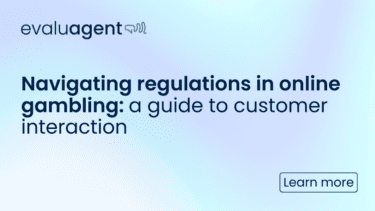Navigating regulations in online gambling: a guide to customer interaction


October 2023 saw the Gambling Commission issue updated formal guidelines to remote gambling operators, bringing customer safety to the forefront. The new framework outlines how operators must take a more proactive approach to customer interaction, placing more responsibility on contact centers and quality assurance teams to consistently and compliantly safeguard their customers.
But what are the new guidelines? And how specifically will they impact contact center operations?
The Gambling Commission’s new framework, ‘Identify, Act, Evaluate’, is designed to effectively detect and address potential gambling-related harms customers may be experiencing, or at risk of.
This stage is an ongoing process of monitoring, using harm indicators to identify signs that a customer may be at risk. As a minimum, these include:
Using harm indicators represents just one of five specific requirements associated with the Identify stage. Other requirements include:
1. Support measures in place for vulnerable customers
2. Effective systems and processes to monitor all customer activity
3. Ensuring customers remain protected via third parties
4. The greater the harm detected, the faster the intervention
Learn more about Requirements 3 to 7 on the Gambling Commission’s website.
If you’ve identified customers at risk, blanket responses won’t meet the new compliance standards. The Gambling Commission’s requirements in the ‘Act’ phase of the framework explicitly stress the need for specific actions and speed depending on the customer’s activity. The four requirements include:
1. Action taken should be proportionate to the level of harm identified and in a timely manner
2. Tailor and escalate the action as appropriate – from light intervention (signposting gambling management) to very strong interaction (refusing the service) depending on the harm detected
3. Prevent marketing and new bonus offers if you’ve detected strong indicators of harm
4. Use automation to swiftly take action to minimise harm where there are strong indicators
This will mean that not only will your systems need to be set up for automated detection, but your staff will need plenty of training to ensure they know how to safely interact and escalate when needed. See a full breakdown of Requirements 8 to 11 on the Gambling Commission’s website.
Evaluation is vital to understanding whether the ‘Identify’ and ‘Act’ stages are having the desired positive impact on your customers. To align with the updated regulations, licensees must conduct impact assessments of individual interactions and overall system effectiveness. The formal requirements include:
1. Evaluate the impact of actions on a customer’s behavior
2. Provide assurance that customer interaction processes are effective
3. Ensure the number of customer interactions is at minimum in line with problem gambling rates
Requirement 14, the last in the list, acts as a backstop protection, mandating licensees to provide a minimum acceptable level of monitoring and interaction. Remote gambling operators are advised to monitor progress monthly so that they meet the minimum interactions over a year.
Learn more about Requirements 12 to 14 on the Gambling Commission’s website.
By adhering to the ‘Identify, Act, Evaluate’ framework, gambling operators not only get a better view of customer safety, but can also provide effective support at the right time to vulnerable customers.
Naturally, these stringent requirements will place a lot of the responsibility on contact centers, in particular agents. The need for constant monitoring and tailored actions will necessitate not only enhanced automation measures, but substantial staff training to appropriately handle the ‘Act’ phase of the framework and keep good records.
Quality assurance teams will also find themselves at the forefront of compliance, with a focus on evaluating the impact of individual interactions and the overall effectiveness of processes. On top of regular quality monitoring, QA teams will need to develop processes to assess the outcomes of actions taken, ensuring that they align with the regulatory requirements.
The specific mention of automated processes to help facilitate timely responses to strong harm indicators (Requirement 11) will require contact centers to adapt and implement advanced technologies. This is not always an easy shift, but is certainly the way forward when it comes to not only protecting customers, but meeting compliance requirements.
Ultimately, contact centers must double down on their monitoring capabilities, while QA teams need to leverage technology and develop robust evaluation processes to maintain compliance. It’s a lot of work, but doing so is worthwhile to create a safer and more responsible gambling environment for customers.
Failure to comply with the standards can mean severe penalties. The Gambling Commission doesn’t hesitate to hand out hefty fines – with one business forced to pay £6 million for several, repeat failures to protect its customers.
All operators should be looking after their customers with vigilant monitoring and action because it’s the right thing to do, not just because of the financial deterrent.
We can help you take the stress out of compliance with a blend of AI and automated agent improvement. evaluagentCX can help you to:
And that’s just the beginning. evaluagentCX also comes packed with agent engagement features to gamify learning and reward great customer service, as well as a suite of smart reports to help you track progress in line with regulations.

Leave random sampling behind and step into an era of QA where efficiency meets accuracy. Here, your most critical interactions are not only monitored, but enhanced with automation to elevate your customer experience.
Take the self-guided tour